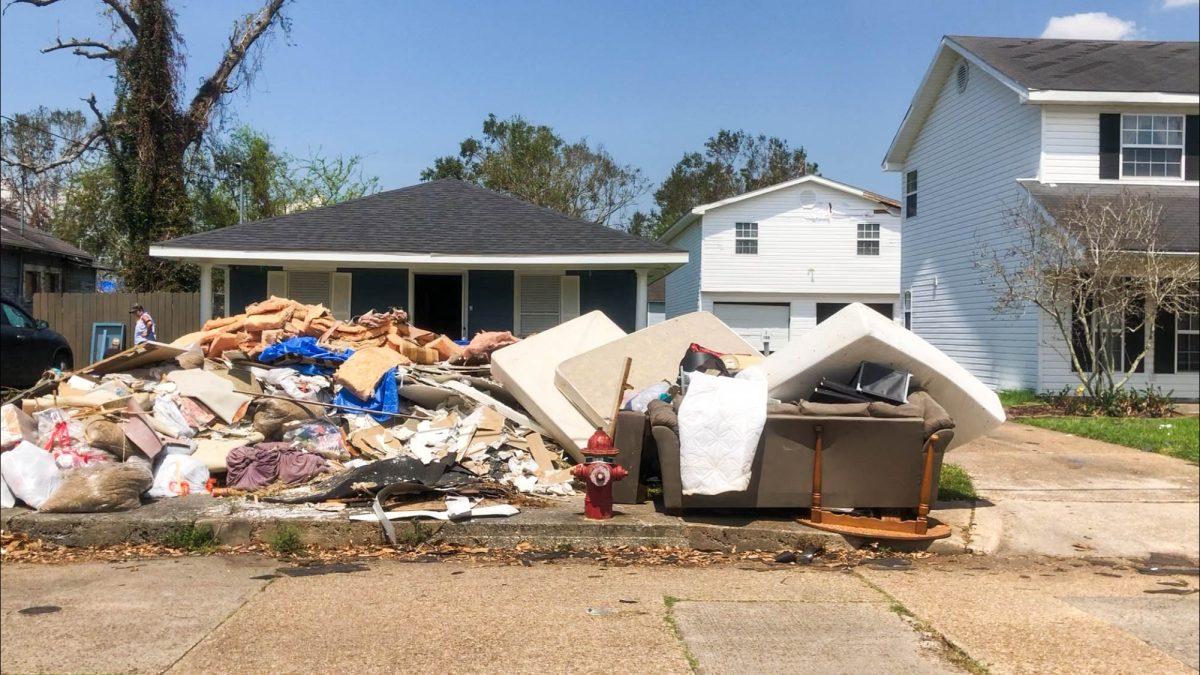The smells of hot rubber and stagnant ocean water mingle in the soupy air of Lake Charles, Louisiana. Sweaty residents drag ruined belongings out of homes. The background lull of generators interrupted by the staccato of nail guns has been going on for weeks.
Two major hurricanes hit only six weeks apart. Scientists warn this is the start of the new normal.
Category 4 Hurricane Laura hit Lake Charles in late August. Debris from six weeks of cleaning streets and repairing damage was tossed to the winds when Hurricane Delta again brought the city back to its knees.
Faced with the scale of destruction, some people have decided to relocate permanently.
With homes unlivable after the storms, some residents have been forced to live with neighbors or family. Cheryl Ware, a Lake Charles native, said she has had to leave her longtime home downtown until the water damage can be repaired.
“I think we’re getting affected a lot more because we don’t have the coastline that we used to and that’s unsustainable,” said Ware. “We used to be where people evacuated to.”
The floor in her home is covered with white powder residue from sheetrock. The only contents are construction-related — a ladder, some paint cans and a stack of tiles. Even as she oversees home repairs, Ware said she is considering leaving for greener pastures.
“I’ve got a backup, and it’s the Hill Country,” Ware said. “I’ve got relatives there, and they don’t get hurricanes.”
Hurricanes cause more death and destruction than any other type of natural disaster, according to the National Environmental Education Foundation. As low pressure systems, hurricanes like heat. The hotter the water, the more powerful the storm. In the warmer-than-average waters of the Gulf of Mexico, hurricanes grow dramatically, according to NEEF.
As global temperatures rise storms will get bigger and more destructive, warn NEEF experts, with as much as 20 percent more precipitation near the storm’s eye and a 2-11 percent increase in intensity across the board.
In Lake Charles, the evidence is scattered over a hundred rain-soaked miles.
“To have to go through every bit of your belongings, and to figure out what to keep and what’s beyond repair … it’s really so depressing,” Carla Chrisco said, Ware’s neighbor of more than 30 years.
Extreme weather events, including hurricanes, will get more powerful and damaging in the future, said Andrew Dessler, Ph.D., a professor in the Texas A&M Department of Geosciences.
“We’re going to get more intense precipitation events,” Dessler said, “things like Hurricane Harvey. You know, climate change predicts we’re going to get really heavy intense rainfall events exactly like that.”
The repercussions of more powerful storms will increase over the next several decades, as well, Dessler said. People will pay the price in lost lives and property damage, he said.
“Look at 2020,” Dessler said. “Look at all the hurricanes. Look at the hurricane damage, look at the rain events, look at the fires and realize that this is the rest of your life.”
Dessler’s message is stark: “You’re going to look back on this as the good old days.”
“You’re going to look back on this as the good old days”
November 22, 2020
Photo by Mitchell Beddingfield
Homes in Lake Charles have been gutted after two major hurricanes strike. Due to roof damage caused by the winds from Hurricane Laura, Hurricane Delta rained in hundreds of homes, rendering them temporarily uninhabitable.
Donate to The Battalion
Your donation will support the student journalists of Texas A&M University - College Station. Your contribution will allow us to purchase equipment and cover our annual website hosting costs.




















